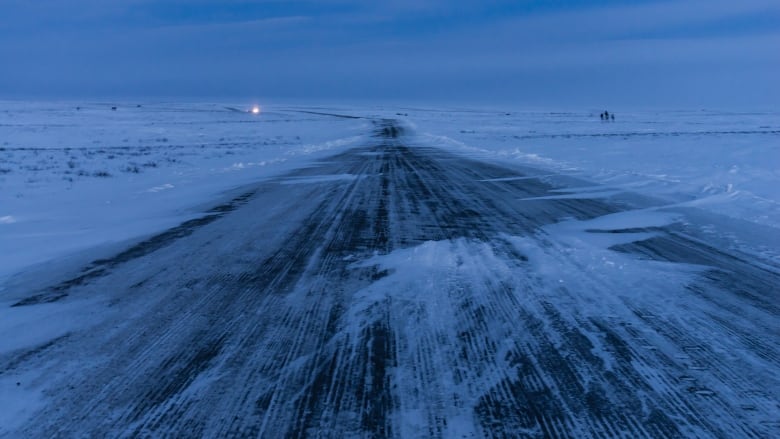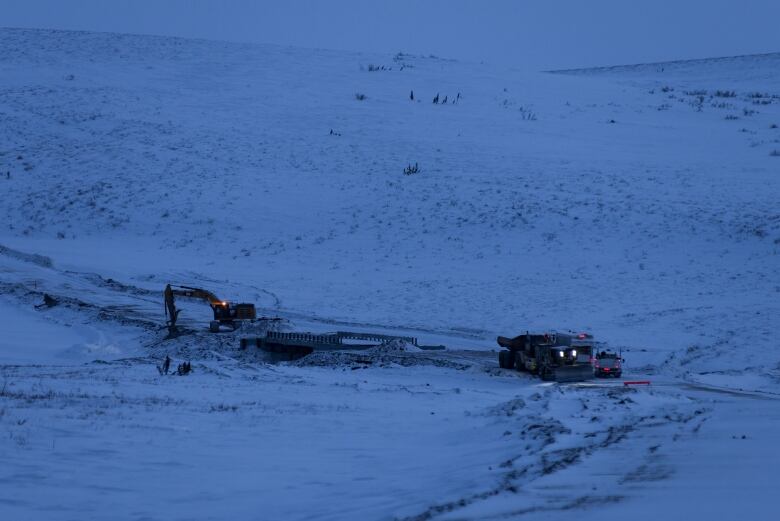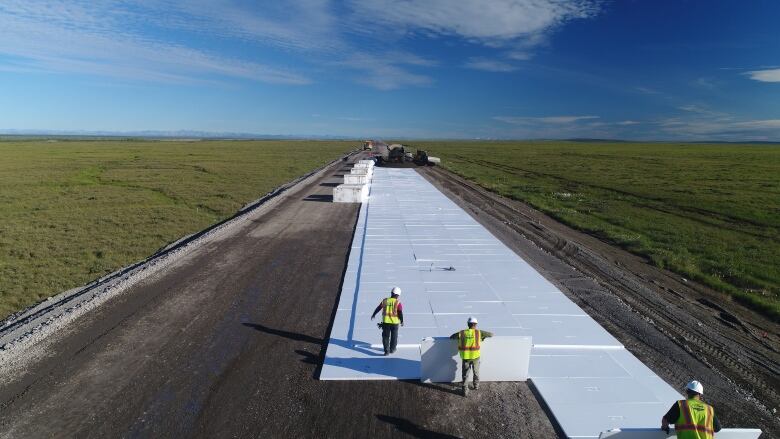'Living, moving, breathing' road to the Beaufort Sea will be under the microscope
Researchers will study the behaviour of the Inuvik to Tuktoyaktuk highway for years to come

Building the road was only half the battle.
Keeping it in one piece with the freeze and thaw of its underlying permafrost, and in the face of the threat of global warming, will be a monumental task as well.
The Inuvik to Tuktoyaktuk highway will open this week. At 137 kilometres, it's not the longest unpaved road in the North, but with a price tag of just under $300 million, it may be one of the most expensive on a per kilometre basis.
It's also unique among road-building projects, explained Merven Gruben, vice-president of E. Gruben's Transport Ltd., one of the companies involved in building the road.

Construction was limited to winter months so tundra and underlying permafrost would not be damaged. But winter in the North has been getting shorter, or at least felt that wayduring the past four years of construction.
"Our biggest obstacle was the season was getting shorter,"Gruben said.
The highway cost $2.2 million per kilometreto build, and will cost another $12,000 to $15,000 per kilometre every year to maintain. That means at least $1.5 million in annual maintenance costs, or about $1 million more every year than it cost to build the annual winter ice road between the two communities.
'Living, moving, breathing' road
The high costs of building the road and maintaining it are not only because of the premium paid for any construction project in Northern Canada, but because the road is built on what is essentially a living terrain of streams, tundra and rock.
"It's a living, moving, breathing form of infrastructure," said Kevin McLeod, the assistant deputy minister of asset management for the Northwest Territories government.
"We are in a very complex environment in the North. It's a project that has never been undertaken anywhere else in the world."
Rick Hoos can attest to that. He's the principal consultant for Kiggiak EBA Consulting Ltd., a company involved in the environmental assessment, permitting andconstruction of the highway.
"It's located on permafrost," he said. "The top twometres of the terrain thaws in the summertime. One of the ways of dealing with that is to build a berm which is the road deep enough so that the ground below will remain frozen. The road itself acts as an insulator."

"The key to it is to have the road base deep enough so that the ground underneath the road base will not thaw in the summer time and that's the primary principle on which the road was built."
Researchers are monitoring the underlying cogency of that primary principle.
"I'm involved in research to find possible solutions for expected deformations," said Marolo Alfaro, a professor of geotechnical engineering at the University of Manitoba.
His project is funded by the government of the Northwest Territories. Alfaro and his team are more than two years into a six-year study. They have been monitoring certain sections of the highway with sensors to get a better understanding of the stability of the embankments the road lays on.
The road was built with this kind of study in mind. Test sections were included during construction to gauge the effectiveness of different road reinforcement methods.
Alfaro said that after this spring thaw they recorded some movement but nothing catastrophic.
He said they are hoping to monitor the effectiveness of road reinforcement on certain sections of the road. So far, "the reinforced section showed less lateral movement compared to the one without reinforcement."
Now that the road is about to open, he says the focus will be on how the different sections of the road hold up once there is regular traffic.
Heavy use intended
Dean Ahmet, the senior program manager for the highway, said he's confident the road will succeed, and that "as the highway ages, in fact it becomes a better highway" as the core embankment of the road solidifies, and the frozen ground rises up to the surface to create a more solid road.

Ahmet says the road is designed for heavy traffic, and that geotextile materials are placed on the terrain throughout the highway in order to make sure that heat doesn't melt the tundra underneath the road.
"The highway is designed for heavy traffic,"Ahmetsaid. "It's a highway that's built to take any available size of truck."
"We've looked at some of the highways built in the Arctic Circle in Alaska and we also have good experience operating theDempsterHighway."
He said government teams of experts have even visited Russia to gather information about road building in northern environments.
"We are very confident that the highway is behaving as it is designed and expected to operate."
Not the only road built on permafrost
In Alaska, northern sections of the Dalton highway are similar to the Inuvik to Tuktoyaktuk highway built as it is over similar terrain.

It was initially constructed in 1975 to assist with the Trans-Alaska oil pipeline.
"There's a lot of challenges that we are continuing to work on," said Ryan Anderson theregional director for the Department of Transportation in Northern Alaska.
"From the ground that continually moves on you and the permafrost terrain, there is a constant maintenance effort on the road."
He saysthe road is still performing well but maintenance costs have increased.
Anderson said the highway to Tuktoyaktuk is going to be "hugely beneficial" in terms of research and future road development in the Arctic.
"This is a big feat to build a new road like that. It's a big accomplishment these days and it's a big investment," he said.
"I'm a big advocate for us all working together and learning together so we can repeat successes and not mistakes."
The official opening for the highway is Nov. 15.












_(720p).jpg)


 OFFICIAL HD MUSIC VIDEO.jpg)
.jpg)



























































































